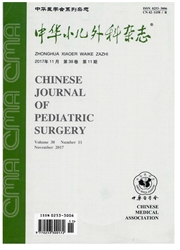

 中文摘要:
中文摘要:
目的探讨胆道闭锁患儿术前营养状态对术后胆管炎发生的影响。方法对2014年1月至2014年12月底收入我院的66例经手术探查确诊为III型胆道闭锁的患儿采用STRONGKid方法进行营养不良风险评估并分组:低度营养不良风险组,中度营养不良风险组及重度营养不良风险组。通过门诊及电话进行随访,随访内容为首次发生胆管炎的时间,早期胆管炎发生情况及术后3个月内发生胆管炎的次数,术后6个月内黄疸消退情况。结果低度营养不良风险患儿0例,中度营养不良风险患儿30例(45.5%),重度营养不良患儿36例(54.5%)。中度营养不良组首次发生胆管炎的时间(44.31±18.75)d明显晚于重度营养不良组(26.75±7.96)d,P=0.002;中度营养不良组早期胆管炎的发生率13.3%明显低于重度营养不良组66.7Z,P=0.04;重度营养不良组患儿术后3个月内胆管炎的平均发生次数(2.11次/人)明显高于中度营养不良组(1次/人),中度营养不良组术后6个月黄疸清除率60.0%高于重度营养不良组16.7%o,P=0.014。结论胆道闭锁患儿术前合并重度营养不良易于发生早期胆管炎且反复发生,中度营养不良组的患儿首次发生胆管炎的时间明显晚于重度营养不良组,重度营养不良组术后黄疸清除率明显低于中度营养不良组。
 英文摘要:
英文摘要:
Objective To explore the effects of preoperative nutritional status on postoperative cholangitis in patients with biliary atresia (BA). Methods From January 1 2014 to December 31 2014,a total of 66 BA patients undergoing Kasai portoenterostomy were divided into 3 groups according to the scores of nutritional risk screening tool STRONGkid. The follow-ups were conducted at outpatient department or by telephone. Results None of them carried low nutritional risks preoperatively (0%). And the preoperative nutritional risks were moderate (n = 30, 45.5%) and high (n = 36,54. 5 %). The occurrence of initial postoperative cholangitis was later in moderate-risk patients than that in high-risk counterparts (P = 0. 002) ; The incidence of early eholangitis in moderate-risk patients was lower than high-risk counterparts (P = 0. 04) ; The incidence of cholangitis within 3 months postoperatively was significantly lower in moderat~risk patients than that in high risk counterparts; The incidence of jaundice clearance within 6 months postoperatively was significantly higher in moderat-risk patients than that in high-risk counterparts (P = 0. 014). Conclusions Patients with high nutritional risks are more vulnerable to early cholangitis and the rate of jaundice clearance is lower in those with moderate or low risks. The occurrence of initial postoperative cholangitis in moderate-risk patients is later than that in high-risk counterparts.
 同期刊论文项目
同期刊论文项目
 同项目期刊论文
同项目期刊论文
 期刊信息
期刊信息
